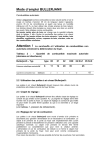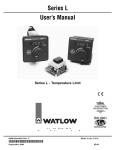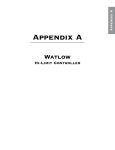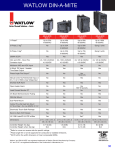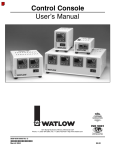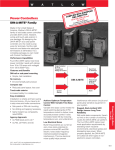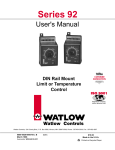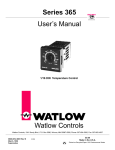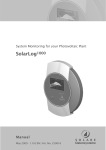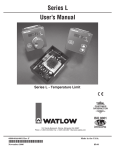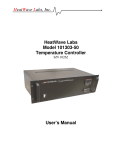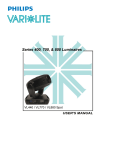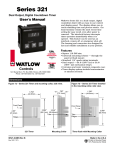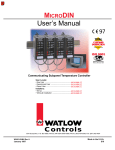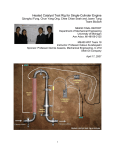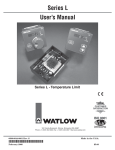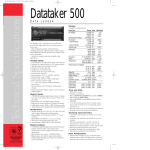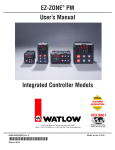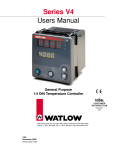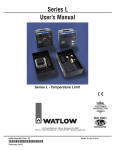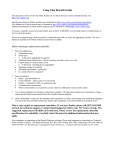Download Operation Manual 02/2003
Transcript
1 Wa t l o w M i c r o D I N Q u i c k S t a r t G u i d e MicroDIN Quick Start Guide Communicating Subpanel Temperature Controller Watlow Winona 1241 Bundy Blvd., P.O. Box 5580, Winona, MN 55987-5580 Phone: (507) 454-5300, Fax: (507) 452-4507 www.watlow.com 0600-0011-0002 Rev B February 2003 $5.00 2 Watlow MicroDIN Quick Start Guide Introduction to the MicroDIN Controller The Watlow MicroDIN controller is a DIN rail-mounted, temperature controller. It uses one input and two outputs, network connections and dozens of parameters to satisfy a broad variety of control needs. The single input can use either a thermocouple or RTD sensor. The single control output provides an open collector or switched dc output signal for a power switching device with a DC input. The single alarm output is an electromechanical relay. The network connections allow as many as 32 controllers to be configured and monitored from a single personal computer. You can configure, operate and monitor the MicroDIN almost entirely from a PLC or personal computer via a serial connection using RJ-11 jacks. Indicator lights on the face of the controller monitor error states, power, communications activity and output activity. Communications Input and Output to and from Personal Computer MicroDIN MicroDIN MicroDIN MicroDIN Temperature Controller Temperature Controller Temperature Controller Temperature Controller Address Power Power Power Comms Comms Comms Power Comms Control Output Control Output Control Output Control Output Alarm Alarm Alarm Alarm Input Error Input Error Input Error Input Error 1 Address 2 Address 3 Address 4 1-32 devices/ EIA-485 Network Figure 2 - MicroDIN inputs and outputs in a thermal system Per Unit: • Sensor Input from the process • Control Output to the process • Alarm Output about the process Note: An electronic copy of this MicroDIN Quick Start Guide and the full version MicroDIN User’s Manual is available at www.watlow.com/prodtechinfo. Search on keyword MicroDIN. 3 Watlow MicroDIN Quick Start Guide Setup Steps 1. Set up communications. 2. Set the controller’s address and baud speed with the DIP switches on the top panel (see page 6). The controller uses eight data bits with no parity. 3. Mount the controller (see pages 9 and 10). 4. Wire the controller (see pages 12-14). 5. Communicate with MicroDIN via an EIA-485 network with Modbus™ RTU protocol. Indicator Lights Figure 3 - MicroDIN indicator lights Power Green light stays lit when the power is on and the controller is ok. • If it isn’t on or pulsates, check your power source. MicroDIN Temperature Controller Power Control Output Green light is lit or flashes when the control output is energized. • If it does not light up, the output is not turning on. Alarm Red Light is lit during an input alarm condition. If it is lit: • Correct alarm condition or change alarm configuration. • Reset the alarm if it is latched. Comms Control Output Alarm Input Error Address Communications Green Light pulsates when the controller sends or receives valid data over its network port. • If it does not light up, check the controller address and the communications setup. Input Error Red Light is lit if there is a sensor problem. If it is lit: • Verify the sensor wiring, polarity and function. • Rewire or replace as necessary. Address Field Record the unit’s address in erasable marker here. 4 Watlow MicroDIN Quick Start Guide Communications Overview EIA-485 Network The MicroDIN uses the EIA-485 (formerly, “RS-485”) hardware interface to communicate with three wires in a half-duplex configuration, up to 32 remote devices with a master unit on a network up to 4,000 feet long using 14-26 gauge wire. Modbus™ Protocol The MicroDIN uses Modbus™ RTU protocol to read and write to registers that can be viewed or changed from a personal computer. Each MicroDIN ‘parameter’ has a corresponding Modbus™ register and access privileges. The MicroDIN parameter register numbers and the order of priority appear later in this chapter. Chapter 5 details all the MicroDIN parameters, and the Appendix provides information on how to write custom Modbus™ applications Set Address/Baud Rate You must configure the communications speed and network address of the MicroDIN controller with the eight-bit DIP switch on the top of the unit. Set the controller address with the first six switches and the network speed (9,600 or 19,200 baud) with the eighth switch. Turn to the DIP switch page 6. Serial Data Format The MicroDIN uses the an 8-N-1 data format; 8 data bits, no parity, 1 stop bit, and 1 start bit. See the data format table later in this chapter. Wiring Tasks In addition to wiring the controller’s input, outputs and power connections, you must also wire the EIA-232-to-EIA-485 converter; connect your computer to the MicroDIN, and connect the MicroDIN communications daisy chain. See “Communications Wiring” on pages 14 and 15. Communications Software Watlow offers a Windows application for MicroDIN, called, WATVIEWTM which will both set up and run multiple MicroDINs over an EIA-485 network using the Modbus™ protocol. For more information on WATVIEWTM, , go to www.watlow. com/products/software. You may also write your own application (see Appendix for more detail), or purchase any of several available Modbus-capable control software packages. 5 Watlow MicroDIN Quick Start Guide Modbus™ Register Numbers Address Address Absolute Relative Parameters Absolute Relative Parameters 40001 0 Model Number (Diagnostics) 40601 600 Sensor Type (Input) 40002 1 Serial Number (Characteristics) 40602 601 Input Type (Input) 40003 2 Serial Number 2 (Characteristics) 40603 602 Range Low (Input) 40004 3 Software ID number (Characteristics) 40604 603 Range High (Input) 40005 4 Software Revision (Characteristics) 40605 604 Filter Time Constant (Input) 40006 5 Date of Manufacture (Characteristics) 40606 605 Calibration Offset (Input) 40007 6 Ship Date (Characteristics ) 40607 606 Decimal Point (System) 40017 16 Control Output Hardware (Control Output) 40608 607 Error Clearing Mode (Error) 40018 17 Alarm Output Hardware (Alarm) 40701 700 Control Output Function (Control Output) 40025 24 Disable Non-volatile Memory (System) 40714 713 Power Limit Set Point (Control Output) 40101 100 Input Actual (Input) 40715 714 High Side Power (Control Output) 40102 101 Input Error (Input) 40716 715 Low Side Power (Control Output) 40104 103 Output Power (Control Output) 40718 717 Alarm Output Function (Alarm Output) 40107 106 Alarm Condition (Alarm Output) 40720 719 Alarm Type (Alarm Output) 40201 200 Operation Mode (Operation) 40721 720 Alarm Hysteresis (Alarm Output) 40205 204 PID Output Power (PID) 40722 721 Alarm Latching Mode (Alarm Output) 40206 205 Proportional Term (PID) 40723 722 Alarm Silencing Mode (Alarm Output) 40207 206 Integral Term (PID) 40724 723 Alarm Active Sides (Alarm Output) 40208 207 Derivative Term (PID) 40725 724 Alarm Logic (Alarm Output) 40210 209 System Error (Error) 40901 900 Units Type (System) 40211 210 Open Loop Error (Error) 40902 901 C or F (System) 40301 300 Set Point (Operation) 40903 902 Input Error Action (Input) 40302 301 User Operation Mode (Operation) 40904 903 Fixed Manual Output (Control Output) 40305 304 Auto-tune Set Point (PID) 40905 904 Activate Open Loop Detect (Error) 40306 305 Initiate Auto-tune (PID) 41501 1500 Ambient (CJC) Temperature (System) 40311 310 Manual Output Power (Operation) 41502 1501 Ambient (CJC) A-to-D Counts (Diagnostics) 40312 311 Clear Error (Error) 41503 1502 RTD Lead Compens. A-to-D Counts (Diag) 40322 321 Alarm Low (Alarm Output) 41504 1503 RTD Lead Resistance (Diagnostics) 40323 322 Alarm High (Alarm Output) 41505 1504 Input A-to-D Counts (Diagnostics) 40332 331 Clear Alarm (Alarm Output) 41513 1512 Enter Diagnostics Mode (Diagnostics) 40333 332 Silence Alarm (Alarm Output) 41514 1513 Test Displays (Diagnostics) 40501 500 Proportional Band (PID) 41515 1514 Test Outputs (Diagnostics) 40502 501 Integral (PID) 41601 1600 Enter Calibration Mode (Calibration) 40503 502 Reset (PID) 41602 1601 Restore to Factory Calibration (Calibration) 40504 503 Derivative (PID) 41603 1602 Reset Factory Defaults (Calibration) 40505 504 Rate (PID) 41604 1603 Calibration Commands (Calibration) 40507 506 Cycle Time (PID) 40508 507 Control Output Hysteresis (PID) 6 Watlow MicroDIN Quick Start Guide MicroDIN DIP Switches Set Address/Baud Rate Configure the communications speed and network address of the MicroDIN controller with the eight-bit DIP switch on the top panel. Set the controller address with the first six switches. Set an address between 1 and 63. The network will not work correctly if any two controllers have the same address. DIP switch 1 sets the left-most binary digit. Switch 6 sets the right-most digit. Record the MicroDIN’s address in erasable marker on the white space on the front of the unit. The seventh switch has no effect. Set the network speed (9,600 or 19,200 baud) with the eighth switch. Figure 6 MicroDIN top view with DIP switches and baud settings O N ↑ O N ↑ 1 2 3 4 5 6 7 8 9600 baud (bit 8 on) 1 2 3 4 5 6 7 8 19.2k baud (bit 8 off) 1 2 3 4 5 6 7 8 O N ↑ Top View O N ↑ Table 6 Decimal-to-binary conversion Dec. 1 2 3 4 5 6 7 8 9 10 11 12 13 14 15 1 2 3 4 5 6 7 8 Binary 000001 000010 000011 000100 000101 000110 000111 001000 001001 001010 001011 001100 001101 001110 001111 O N ↑ Dec. 16 17 18 19 20 21 22 23 24 25 26 27 28 29 30 31 1 2 3 4 5 6 7 8 Binary 010000 010001 010010 010011 010100 010101 010110 010111 011000 011001 011010 011011 011100 011101 011110 011111 O N ↑ Dec. 32 33 34 35 36 37 38 39 40 41 42 43 44 45 46 47 1 2 3 4 5 6 7 8 Binary 100000 100001 100010 100011 100100 100101 100110 100111 101000 101001 101010 101011 101100 101101 101110 101111 O N ↑ Dec. 48 49 50 51 52 53 54 55 56 57 58 59 60 61 62 63 1 2 3 4 5 6 7 8 Binary 110000 110001 110010 110011 110100 110101 110110 110111 111000 111001 111010 111011 111100 111101 111110 111111 7 Watlow MicroDIN Quick Start Guide Required Parameters Setup Order This table provides 1) the correct order of entry, 2) the effect of a parameter change, and 3) a place to document settings. Parameters should be set up in this order. Uni ts T ype Co rF Con trol Out Sen put sor Fun T ctio y p Inpu e n t Ty p e Ran ge Ran Low ge H igh Hig hS ide Pow Low er Side Pow Alar er mT ype Ope rati Dec on Mod ima e l çCAUTION: ➝ ➝ Changing this ➝ Affects this Units Type C or F Input Error Action Control Output Function Set Fixed Manual Output Open Loop Detect Sensor Type Input Type Range Low Range High Decimal Point Calibration Offset Filter Time Constant Error Clearing Mode Power Limit Set Point High Side Power Low Side Power Alarm Output Function Alarm Type Alarm Hysteresis Alarm Latching Mode Alarm Silencing Mode Alarm Active Sides Alarm Logic Alarm High Alarm Low Propband Integral O Reset O Derivative Rate Cycle Time Output Hysteresis Operation Mode Set Point Manual Output Power Set Point Table 7 - Parameters Setup order O O D D D D D C C D D D D D C C D D C C D D D D C C C C D D D D D D C D D C C C O O O C O O C O O D D O O C C C O C Key: D = Changing will change the default C = Changing will convert the temperature scale O = Other effect (see Ch. 5) Document your settings below 8 Watlow MicroDIN Quick Start Guide Serial Data Format Configure your computer’s COM1 or COM2 (communications) port data format to match the MicroDIN’s settings in the table below. Table 8a Serial Data Format Data Bits Parity Stop Bit Start Bit 8 None 1 1 MicroDIN Installation Wiring Tasks MicroDIN requires these wiring tasks for a successful installation 1. Wire MicroDIN sensor input. 2. Wire MicroDIN Output 1, the control output. 3. Wire MicroDIN Output 2, the alarm output. 4. Wire MicroDIN power. 5. Connect the MicroDIN communications daisy chain. 6. Wire the 232-to-485 converter; connect to the computer. 7. If necessary, wire the termination and pull-up/pull-down resistors. Communications Software WATVIEWTM Figure 8b WATVIEW™ sample software screen Watlow offers a Modbus™ package in WATVIEW™, software that will set up and run multiple MicroDINs over an EIA-485 network. WATVIEW™ is available from any Watlow sales representative or authorized distributor. For more information, go to www.watlow.com /products/software. WATVIEW™ can handle up to 32 MicroDIN units. Other Software To communicate with MicroDIN, you must use a Modbus™ RTU (remote terminal unit) compatible software package. Sending ASCII commands via a standard serial communication application will not work. Refer to the Appendix in the User's Manual if you’re writing your own Modbus™ RTU application. 9 Watlow MicroDIN Quick Start Guide Mounting the MicroDIN To mount a MicroDIN on a DIN rail, hook the upper lip of the rail mounting bracket onto the rail and press the controller down until the bottom lip of the mount snaps onto the rail. To remove, as you push the back of the controller down lift the front up until the bottom lip unsnaps from the rail. To mount a MicroDIN on a panel, use the dimensions below to drill screw holes for the mounting bracket. Figure 9 Mounting a MicroDIN controller bracket for panel mounting (#6 screw or m3.5 required) .318 in (8 mm) Top/bottom mount hole offset Side View MicroDIN Temperature Controller Power 4.225 in (107 mm) 3.750 in (146 mm) Comms Control Output DIN rail 4.650 in (118 mm) Alarm Input Error Address 5.062 in (129 mm) Min. Clearance between rail Front View centerlines 5.750 in (146 mm) Min. Clearance 2 in (51 mm) 1.637 in (42 mm) 2.875 in (73 mm) MicroDIN MicroDIN Temperature Controller Temperature Controller Power Power DIN rail ç CAUTION: Maintain the correct spacing between rows of controllers to allow sufficient air circulation and installation clearance. Failure to do so could result in damage to equipment. Address Comms Comms Control Output Control Output Alarm Alarm Input Error Input Error Address 1.650 in (42 mm) Attachment Angle 10° Use DIN EN 50022 35mm x 7.5mm Rail 10 Watlow MicroDIN Quick Start Guide Mounting the MicroDIN on a DIN rail To Mount MicroDIN 1. Push unit in and down to catch rail hook on top of rail. 2. Rotate bottom of unit in toward rail. ① 3. Rail clasp will audibly “snap” into place. If the MicroDIN does not snap into place, check to see if the rail is bent. Figure 10a Mounting a MicroDIN controller on a DIN rail ➂ "Snap" ➁ To Dismount MicroDIN 1. Press down on back of controller until the bottom hook clears the rail. ① 2. Then rotate bottom up and away from rail. ➁ Figure 10bDismounting a MicroDIN controller from a DIN rail 11 Watlow MicroDIN Quick Start Guide MicroDIN RJ-11 and 10-pin Connectors The MicroDIN 10-pin screw terminal connector, on the bottom of the case, links it to its power supply, control input, control output and alarm output. Use 26- to 14-gauge wire to connect to the plug terminals. The alarm output is an electromechanical relay. See the Appendix for information on sensor ranges and specifications. See Chapter 5: Parameters for information about software configuration. ABCD Figure 11 - Bottom view of MicroDIN case with connector assignments communications sockets 1 and 2 (RJ-11) Bottom View Ó Front of Unit WARNING: To avoid potential electric shock, use National Electric Code (NEC) safety practices when wiring and connecting this unit to a power source and to electrical sensors or peripheral devices. Failure to do so could result in injury or death. 1 2 3 4 5 6 7 8 9 10 1 2 3 4 5 6 7 8 9 10 10-pin removable connector ç WARNING: Install high or low temperature limit control protection in systems where an over temperature fault condition could present a fire hazard or other hazard. Failure to install temperature limit control protection where a potential hazard exists could result in damage to equipment and property and injury to personnel. Input 1. S1 or thermocouple+ 2. S3 or thermocouple3. S2 Control Output 4. dc+ 5. dc6. common (COM) Alarm Output (electromechanical relay) 7. alarm normally open (NO) 8. alarm common (COM) Power 9. L2, 24V‡ (ac/dc)10. L1, 24V‡ (ac/dc)+ 12 Watlow MicroDIN Quick Start Guide Input Wiring Figure 12a — MicroDIN Isolation Diagram Power Supply Safety Isolation Logic and Input Outputs UL/CE Comms 500V Noise Isolation Control Output Alarm Figure 12b — Control Input, Thermocouple 1 2 3 4 5 6 7 8 9 10 + - Figure 12c — Control Input, 2-wire RTD 1 2 3 4 5 6 7 8 9 10 S1 S3 Figure 12d — Control Input, 3-wire RTD 1 2 3 4 5 6 7 8 9 10 S1 S2 S3 13 Watlow MicroDIN Quick Start Guide Output and Power Wiring Figure 13b — Control Output, Open Collector with External Power Supply dc + dc C O M dc + dc C O M Figure 13a — Control Output, Switched DC with Internal Power Supply 1 2 3 4 5 6 7 8 9 10 1 2 3 4 5 6 7 8 9 10 + External External Switching Load Device External External Switching Load Device - - Power + + 42V max. Supply 1A max. Figure 13c — Internal Output Circuitry Ó WARNING: To avoid potential electric shock, use National Electric Code (NEC) safety practices when wiring and connecting this unit to a power source and to electrical sensors or peripheral devices. Failure to do so could result in injury or death. +24VÎ(dc) 2KΩ 20Ω Internal Circuitry 4 dc+ 5 6 dc- COM Figure 13d — Alarm Output N .O C . O M Figure 3.4e — Power Wiring 1 2 3 4 5 6 7 8 9 10 1 2 3 4 5 6 7 8 9 10 Fuse NOTE: Relay suppression required only for inductive loads. Relay Suppression L1 24V‡ (ac/dc) External Load - + L2 Ó WARNING: If high voltage is applied to a this 24V controller, irreversible damage will occur. 14 Watlow MicroDIN Quick Start Guide Communications Wiring Figure 14a- MicroDIN communications daisy chain via RJ-11 connectors MicroDIN MicroDIN MicroDIN MicroDIN Temperature Controller Temperature Controller Temperature Controller Temperature Controller Power Power Power Comms Comms Comms Comms Control Output Control Output Control Output Control Output Alarm Alarm Address Alarm Input Error Input Error Note: If your network doesn’t function, see Special 485 Network Considerations section. Address 1 2 Power Alarm Input Error Address Input Error Address 3 4 Converter-To-MicroDIN Wiring Example RJ-11 to MicroDIN Ó WARNING: To avoid potential electric shock, use National Electric Code (NEC) safety practices when wiring and connecting this unit to a power source and to electrical sensors or peripheral devices. Failure to do so could result in injury or death. AB CD TD (A) TD (B) RD (A) RD (B) TD (A) TD (A) SIG GND EIA-485 EIA-232 Figure 14b- B&B Converter to MicroDIN Wiring (B&B Electronics Manufacturing Company, Ph. 815-433-5100) www.bb-elec.com Green Yellow EIA-485 + – Power Supply AD-1210 120V~ 120VÅ (Vac) DI/O DI/O EIA-485 ADA485L G B A B A 9ÎVdc (see NOTE) Comms Plug Yellow Red Green Yellow AB CD EIA232 G 9VDC Figure 14c - CMC 0219-0217-0000 Converter to MicroDIN 7 ft. comms cable Wiring (CMC Connecticut MicroComputer, Inc. Ph. 800-426-2872) Note: The CMC converter requires an external power supply when used with a laptop. www.2cmc.com 15 Watlow MicroDIN Quick Start Guide Special EIA-485 Network Considerations If your MicroDIN network doesn't work, it may need termination and pull-up and pull-down resistors; wire them per the diagrams below. Figure 15 a- Termination for MicroDIN; RJ-11 phone plug with 120Ω resistor across C and D ABCD RJ-11 Terminals C (green) and D (yellow) 120Ω Plug terminator into open socket in MicroDIN controller furthest from computer, the last unit on the network. Figure 15b Termination for EIA-232/EIA-485 Converter with pull-up and pull-down resistors +5V Converter box termination with pull-up and pull-down resistors. B T+/R+ A T-/R- GND Com 1KΩ 120Ω 1KΩ 16 Watlow MicroDIN Quick Start Guide Ó WARNING: To avoid potential electric shock, use National Electric Code (NEC) safety practices when wiring and connecting this unit to a power source and to electrical sensors or peripheral devices. Failure to do so could result in injury or death. 120V~(ac) L1 1 3 1 + 4 2 – 5 2 1 3 L2 0830-0474-0000 Supply 3 Power 2 – + 6 Loop PC EIA485 EIA485 7 4 5 6 3 8 8 7 2 MicroDIN UD1A-1CES-0000 9 10 9 1CR-1 4 10 1 11 11 Semiconductor Fuse 2 2 1 5 9 6 8 6 2 DIN-a-mite DA10-24C0-0000 5 3 4 146E-1601-1000 Figure 16 System wiring example, ladder diagram 7 8 3 – 9 10 ç WARNING: Install high or low temperature limit control protection in systems where an over temperature fault condition could present a fire hazard or other hazard. Failure to install temperature limit control protection where a potential hazard exists could result in damage to equipment and property and injury to personnel. 12 1 10 11 13 18 5 20 2 2 1 CR 7 2 17 Series 146 Limit Control 1 12 + 15 16 11 Heater 14 1 High Temp. Light 9 13 14 21 19 Optional Normally Open Momentary Switch 2 17 Watlow MicroDIN Quick Start Guide Wiring Examples Figure 17 System wiring example, schematic L1 120VÅ (ac) L2 Branch Circuit Fuse Earth Ground Watlow MicroDIN Ó WARNING: To avoid potential electric shock, use National Electric Code (NEC) safety practices when wiring and connecting this unit to a power source and to electrical sensors or peripheral devices. Failure to do so could result in injury or death. ç WARNING: Install high or low temperature limit control protection in systems where an over temperature fault condition could present a fire hazard or other hazard. Failure to install temperature limit control protection where a potential hazard exists could result in damage to equipment and property and injury to personnel. High Limit Mechanical Contactor Coil Semiconductor Fuse 0830-0474-0000 Power Supply Temperature Controller UD1A-CES-0000 1 (-) (+) 1 2 3 4 5 6 7 8 9 10 (-) (+) R 12345 6789 2 EIA485 Loop Heater PC OR 146E-1601-1000 DIN-A-MITE 6 5 DA10-24C0-0000 4 3 Thermocouples EIA485 to RS232 Converter High temp. light ModBus Converter Limit Control 10 11 121314 151617 Optional Normally Open Momentary Switch 18 Watlow MicroDIN Quick Start Guide Declaration of Conformity MicroDIN Watlow Winona, Inc. 1241 Bundy Blvd. Winona, MN 55987 USA Declares that the following product: Designation: MicroDIN Model Numbers: UD1A – 1CES – (Any four letters or numbers) Classification: Temperature control, Installation Category II, Pollution degree 2 Rated Voltage: 24V‡ to 24V‡ (ac or dc) Rated Frequency: 50 or 60 Hz Rated Power Consumption: 5VA maximum Meets the essential requirements of the following European Union Directives by using the relevant standards show below to indicate compliance. 89/336/EEC Electromagnetic Compatibility Directive EN 61326:1997 A1:1998 Electrical equipment for measurement, control and laboratory use – EMC requirements (Industrial Immunity, Class A Emissions). EN 61000-4-2: 1996 With A1, 1998: Electrostatic Discharge Immunity EN 61000-4-3: 1997: Radiated Field Immunity EN 61000-4-4: 1995: Electrical Fast-Transient / Burst Immunity EN 61000-4-5: 1995 With A1, 1996: Surge Immunity EN 61000-4-6: 1996: Conducted Immunity EN 61000-4-11: 1994: Voltage Dips, Short Interruptions and Voltage Variations Immunity EN 61000-3-2: 1995 With A1-3:1999: Harmonic Current Emissions EN 61000-3-3: 1995 With A1:1998: Voltage Fluctuations and Flicker 73/23/EEC Low-Voltage Directive EN 61010-1: 1993 With A1:1995: Safety Requirements of electrical equipment for measurement, control and laboratory use. Part 1: General requirements Raymond D. Feller III Winona, Minnesota, USA Name of Authorized Representative Place of Issue General Manager January 2003 Title of Authorized Representative Date of Issue Signature of Authorized Representative (2348) 19 Watlow MicroDIN Quick Start Guide Troubleshooting Alarms and Errors most likely problems are listed first Indication Symptoms • No power. Error = off (Normal = steady green) • Unit will not communicate. Error = off (Normal = pulsing green) • Input is in error condition. Error = steady red (Normal = off ) • Alarm won’t occur. Alarm = steady red • Alarm won’t clear. (Normal = off) Flashing LED Indicator Light Pattern Error 4 Error 5 Error 6 Error 7 Error 11 Error 12 Error 13 Error 14 Error 15 Probable Cause(s) Power • Power supply switch off • Fuse blown • Breaker tripped • Safety interlock door switch, etc. • Separate system limit control may be latched • Open wiring • Power ≤ 20V‡ (ac/dc) Communications • MicroDIN address DIP switch incorrectly set • MicroDIN baud rate DIP switch incorrectly set • MicroDIN unit-to-unit daisy chain disconnected • Reversed, short or open EIA-485 communications wiring • EIA-485 converter box incorrectly wired • Computer COM port incorrectly set up • Communications software setup or address incorrect • Protocol or parity wrong, not 8, n, 1 • Needs termination and pull-up and pull-down resistors Input Error • The sensor is improperly wired • Sensor wiring reversed, shorted or open • MicroDIN firmware setting does not = actual sensor • Power ≤ 20V‡ (ac/dc) • Ambient environmental temperature out of spec for MicroDIN • The MicroDIN open loop detect shows a broken sensor • The calibration offset parameter is set much too high or low Alarms • Alarm output off • Alarm set points incorrect • Alarm silenced • Alarm sides incorrect • In diagnostics mode • Alarm latched • Alarm set points incorrect • Alarm hysteresis incorrect • Input in error condition Errors • RAM malfunction • EEPROM data corrupted • PROM malfunction • Logic hardware problem • New firmware installed • Calibration data corrupted • Analog-to-digital hardware failure • EEPROM hardware problem • New unit first power up 20 Watlow MicroDIN Quick Start Guide Corrective Action • Check switches, fuses, breakers, interlocks, limits, connectors, etc. for energized condition and proper connection • Measure power upstream for required level • Check wire size • Check for bad connections • Check and reset unit DIP switches 1-6 to correct address • Check and reset unit DIP switch 8 to correct baud rate • Look for a break in the daisy chain • Verify correct connections and test wiring paths • Check converter box wiring and its documentation • Reconfigure computer's COM port setup and verify communications ok • Check the communication card documentation for setable variables, operational testing • Restart COMS software, check for settings agreement. Verify COM bus active • Check sensor connections • Check sensor connections and sensor wiring • Change the Sensor Type parameter (Input Group) to match the sensor hardware • Measure power upstream for required level • Verify that the temperature surrounding unit is 32° to 149°F (0° to 65°C) • Check sensor function. The Open Loop Detect parameter (Error Group) indicates it may be broken • Check the Calibration Offset parameter (Input Group) value; set it to a lower level • Send the alarming MicroDIN unit a “clear alarm” signal (Modbus™: 331) Note: The condition causing the alarm must also be resolved for the alarm to clear • To clear the alarm, correct the alarm condition; check to see if the alarm is latched • Check the alarm sides setting • Check the alarm type setting • Check the alarm logic for compatibility with system peripherals and annunciators • Check the power limit setting • Check the operation mode • Check the alarm output function • Check °F/°C setting • Check the calibration offset value; set it to a lower level • Return unit to factory • Cycle power to unit • Return unit to factory • Return unit to factory • Cycle power to unit • Recalibrate unit • Return unit to factory • Return unit to factory • Return unit to factory 21 Watlow MicroDIN Quick Start Guide Specifications: (2346) Control Mode • Microprocessor-based, user selectable control modes • Single input, single output • Heat or cool auto-tuning Output #1: User selectable • ON/OFF; P, PI, PD, PID heat or cool action adjustable switching differential: 1 to 9999 or 0.1 to 999.9°F or °C • Proportional band: 0 to 9999, or 0.0 to 999.9°F or °C • Integral: 0.00 to 99.99 minutes per repeat • Reset: 0.00 to 99.99 repeats per minute • Derivative/Rate: 0.00 to 9.99 minutes • Cycle Time: 0.1 to 60.0 seconds Output #2: User selectable • Process or deviation alarm with flashing alarm status indicator • Alarm with separate high and low set points • Hysteresis: 1 to 9999° switching differential Operator Interface • EIA-485 serial communications with Modbus™ RTU protocol • 9600, 19200 user selectable baud rates • 1 to 63 user selectable address range Sensor Input • Sensor input sampling rate: 10 samples/second, 10Hz • Thermocouple, grounded or ungrounded sensors • RTD 2 or 3 wire, platinum, 100Ω@ 0°C calibration to JIS curve (0.003916Ω/Ω/°C), or DIN curve (0.00385Ω/Ω/°C) • Sensor break protection de-energizes control output to protect system or selectable bumpless transfer to manual operation. • °F or °C, user selectable • Sensor Ranges: Accuracy Ranges: Operating Ranges B t/c 1598 to 3092°F C (W5) t/c 32 to 4200°F D (W3) t/c 32 to 4200°F E t/c -328 to 1472°F J t/c 32 to 1382°F K t/c -328 to 2282°F N t/c 32 to 2282°F PT2 t/c 32 to 2540°F R t/c 32 to 2642°F S t/c 32 to 2642°F T t/c -328 to 662°F 1.0 RTD (DIN) -328 to 1202°F 0.1 RTD (JIS) -199.9 to 999.9°F 870 0 0 -200 0 -200 0 0 0 0 -200 -200 -143 to to to to to to to to to to to to to 1700°C 2315°C 2315°C 800°C 750°C 1250°C 1250°C 1393°C 1450°C 1450°C 350°C 650°C 636°C 32 32 32 -328 32 -328° 32 32 32 32 -328 -328 -328 to to to to to to to to to to to to to 3300°F 4200°F 4200°F 1470°F 1500°F 2500°F 2372°F 2543°F 3200°F 3200°F 750°F 1472°F 1166°F 0 0 0 -200 0 -200 0 0 0 0 -200 -200 -200 to to to to to to to to to to to to to 1816°C 2315°C 2315°C 800°C 815°C 1370°C 1300°C 1395°C 1760°C 1760°C 400°C 800°C 630°C • Tenth degree resolution selectable over sensor operating range within limits of -199.9 to 999.9, except for thermocouple types B, R, and S 22 Watlow MicroDIN Quick Start Guide Primary Control Output (heating or cooling) • Output update rate: 10 per second, 10Hz (maximum) Internal Load Switching (nominal): Switched dc (isolated) signal, 22 to 28VÎ (Vdc), current limited @ 30mA Overload current and short circuit protection External Load Switching (maximum): • Open Collector 42VÎ (Vdc) @ 1A Alarm Output • Output update rate 2 per second (2Hz) • Electromechanical relay, Form A, 2A @ 30VÎ (Vdc) or 240VÅ(Vac), • Alarm output can be latching or non-latching, and process or deviation with separate high and low values. Alarm silencing (inhibit) on power-up. Accuracy • Calibration accuracy and sensor conformity: ±0.1% of span ±1°C @ 25°C ±3°C (77°F ±5°F ) ambient, and rated line voltage ±10% with the following exceptions: Type T; 0.12% of span for -200°C to -50°C Types R and S; 0.15% of span for 0°C to 100°C Type B; 0.24% of span for 870°C to 1700°C • Accuracy span: Less than or equal to operating ranges, 1000°F/540°C minimum. • Temperature stability: ±0.2 °C/°C (±0.2 °F/°F) rise in ambient maximum for thermocouples, ±0.05 °C/°C (±0.05 °F/°F) rise in ambient maximum for RTD sensors • Voltage stability: ±0.01% of span per percent of rated line voltage Safety Agency Approvals • UL/C-UL 508, File # E102269 Industrial Control Equipment • CE to EN 61010 Electromagnetic Compatibility and Immunity • Complies with EN 50081, EN 50082 Terminals • Touch-safe set screw type, accepts 26 to 14 gauge wire Power • 24-28V‡(Vac/Vdc), -15%, +10% [20.4 to 30.8V‡(Vac/Vdc)]; 50/60Hz ±5% for VÅ(Vac) • 5VA typical power consumption • Data retention upon power failure via nonvolatile memory • Sensor input isolation to switched dc output and communication circuitry 500VÅ(Vac) dielectric Operating Environment • 32 to 149°F (0 to 65°C) • 0 to 90% RH, non-condensing • Storage temperature: -40 to 158°F (-40 to 70°C) Dimensions • Width x Height x Depth 1.64" x 4.65" x 5.19" DIN rail mount (42mm x 118mm x 132mm) 1.64" x 4.65" x 5.06" Chassis mount (42mm x 118mm 129mm) • Mounts on DIN rail per DIN EN 50022 (35mm x 7.5mm) UL® is a registered trademark of Underwriters Laboratories. Modbus™ is a registered trademark of AEG Schneider Automation. Adobe® and Acrobat® are registered trademarks of Adobe Systems Incorporated. These specifications are subject to change without prior notice. 23 Watlow MicroDIN Quick Start Guide Ordering Information (2347) To order, complete the code number to the right with the information below: UD1A-1CES-__00 MicroDIN Controller DIN Rail Mount Temperature Controller with no operator interface and EIA-485 Modbus™ RTU Serial Communications. Hardware 1A = Single channel, low voltage Input 1 = Type B, C, D, E, J, K, N, PT2, R, S, T, 1°RTD, 0, 1°RTD (JIS and DIN) Control Output C = Switched (DC), logic signal, isolated. Alarm Output E = 1 Electromechanical relay, Form A, 1A, W/O contact suppression Communications Electromechanical relays are warranted for 100,000 closures only. S = EIA/TIA-485 Communications, opto isolated, Modbus™ RTU protocol Software 00 = Standard XX = Custom software or setup parameters WATVIEWTM Configurator Edition Includes only spreadsheet display, setup screens recipe manager without calendar start. WATVIEWTM-C WATVIEWTM Run-Time Edition Includes all the features of the Configurator edition plus alarm management, recipe calendar start, user event log, data logging, trend graphing. WATVIEWTM-R WATVIEWTM Developer Edition Includes all the features of the Run-Time edition plus capability of developing custom screens. WATVIEWTM-D MicroDIN Accessories 6-inch communications cable (RJ-11, 4 conductor, straight through) 7-foot communications cable (RJ-11, 4 conductor, straight through) 10-pin removable connector with screw terminals Communications converter (EIA-232 to EIA-485) Power Supply 120VÅ (Vac) input, 24VÎ (Vdc) output 0219-0218-0000 0219-0217-0000 0836-0445-0000 0830-0473-0000 0830-0474-0000 24 Watlow MicroDIN Quick Start Guide How to Reach Us Technical Assistance If you encounter a problem with your Watlow controller, review your configuration information to verify that your selections are consistent with your application: inputs, outputs, alarms, limits, etc. If the problem persists after checking the configuration of the controller, you can get technical assistance from your local Watlow representative, or by dialing +1 (507) 494-5656 between 7 a.m. and 5 p.m., Central Standard Time (CST). Ask for for an Applications Engineer. Please have the following information available when calling: • Complete model number • All MicroDIN configuration information • Quick Start Guide or User’s Manual • Computer Hardware / Software Configuration Warranty The MicroDIN is manufactured by ISO 9001-registered processes and is backed by a three-year warranty. Return Material Authorization (RMA) 1. Call Watlow Customer Service, (507) 454-5300, for a Return Material Authorization (RMA) number before returning any item for repair. We need this information: • Ship to address • Bill to address • Contact name • Phone number • Method of return shipment • Your P.O. number • Detailed description of the problem • Any special instructions • Name and phone number of person returning the product. 2. Prior approval and an RMA number, from the Customer Service Department, is needed when returning any unused product for credit. Make sure the RMA number is on the outside of the carton, and on all paperwork returned. Ship on a Freight Prepaid basis. 3. After we receive your return, we will examine the unit and try to verify the reason for the return. 4. In cases of manufacturing defect, we will enter a repair order, replacement order or issue credit for material returned. 5. To return products that are not defective, goods must be be in new condition, in the original boxes and they must be returned within 120 days of receipt. A 20 percent restocking charge is applied for all returned stock controls and accessories. 6. If the unit is unrepairable, it will be returned to you with a letter of explanation. Repair costs will not exceed 50 percent of the original cost. 7. Watlow reserves the right to charge for no trouble found (NTF) returns. The MicroDIN Quick Start Manual is copyrighted by Watlow Winona, Inc., © February 2003 with all rights reserved. (2345) Watlow MicroDIN Quick Start Guide Watlow Controls, 1241 Bundy Blvd., P.O. Box 5580, Winona, MN 559875580, Phone: (507) 454-5300, Fax: (507) 452-4507 Your Authorized Watlow Distributor is:
























